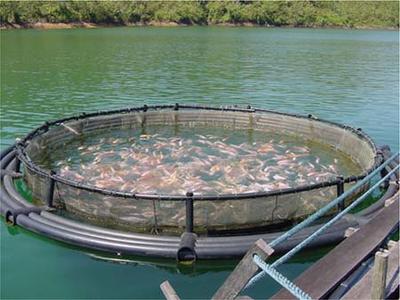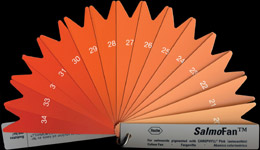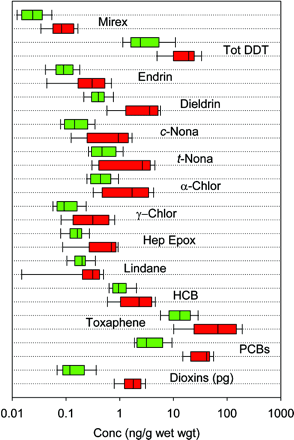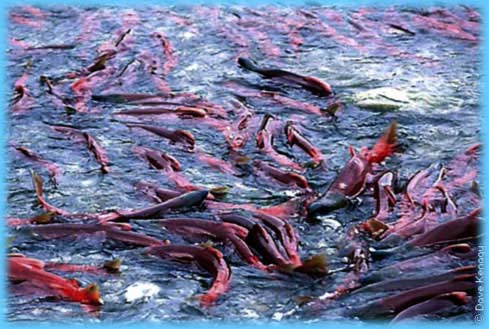 Loading... Please wait...
Loading... Please wait... Loading... Please wait...
Loading... Please wait...
At Topline Foods, we only sell wild-caught salmon. It’s the only kind we’d feed to our families, and it’s the only kind we’d feed yours. We research our products carefully and make the most informed decisions possible; and we’ve compiled it all so that you can make the informed decision between farm-raised and wild-caught salmon too!
Salmon has been long praised as a health food, and for good reason. It’s high in protein, high in Vitamin D, and high in the much sought Omega-3, and low in fat and calories. The only problem is that there are only so many wild salmon that the ocean can support, and with such high global demand, it means that salmon, born wild in the ocean and subject to the laws of its ecosystem, does cost more than your standard mass produced herbivore meats. I mean, it’s not like you can stuff thousands of undomesticated carnivores in a sack with some food pellets, let simmer for about 3 years and expect the end result to be nothing but quality seafood and sweet, sweet profits. Right?
 Well, I guess you can’t blame them for trying. Salmon farms like these are actually doing quite well, and are now producing the majority of the world’s salmon supply according to the World Salmon Farming Industry. But the end results aren’t that pretty. Literally, in fact, as well as figuratively. One of the first things salmon farmers probably realized is that the fish’s namesake color isn’t self-produced. Wild caught salmon gets its color from a life spent hunting and eating krill with a high pigmentation. Meat from farm-raised salmon who never see their natural diet has an ugly, pale grey color that betrays their dull and unnatural lifestyle. So what’s an industry to do? Accept the limitations of their product, and let the consumer weigh its short comings against its economic price? Feed their fish something closer to their natural diet? That would be silly. Let them eat tanning pills!
Well, I guess you can’t blame them for trying. Salmon farms like these are actually doing quite well, and are now producing the majority of the world’s salmon supply according to the World Salmon Farming Industry. But the end results aren’t that pretty. Literally, in fact, as well as figuratively. One of the first things salmon farmers probably realized is that the fish’s namesake color isn’t self-produced. Wild caught salmon gets its color from a life spent hunting and eating krill with a high pigmentation. Meat from farm-raised salmon who never see their natural diet has an ugly, pale grey color that betrays their dull and unnatural lifestyle. So what’s an industry to do? Accept the limitations of their product, and let the consumer weigh its short comings against its economic price? Feed their fish something closer to their natural diet? That would be silly. Let them eat tanning pills!
Salmon raised on farms are dosed with a chemical called canthaxanthin, which can turn them any one of several precise shades of pink. Originally used as a sunless tanning pill for people, canthaxanthin was banned in the United Kingdom for causing retinal damage in some consumers.
 As is the case whenever you cram members of one species as closely as they will physically fit, conditions in these fish farms are extremely unsanitary. They’re also very stressful to the fish, which weakens their immune systems. There’s an incredible list of parasites and diseases that thrive in these huge factory farms, but one of the most problematic epidemics is that of sea lice.
As is the case whenever you cram members of one species as closely as they will physically fit, conditions in these fish farms are extremely unsanitary. They’re also very stressful to the fish, which weakens their immune systems. There’s an incredible list of parasites and diseases that thrive in these huge factory farms, but one of the most problematic epidemics is that of sea lice.
Sea lice feed on the skin, blood and mucous of salmon, create open sores through which other contaminants may enter, and directly weaken the fish’s immune system. A large enough infestation, which can be as little as one sea-louse for young salmon, can be fatal. The industrial solution is to feed the salmon a colorful variety of very toxic pesticides, as well as the standard supplement of antibiotics which contribute to the creation of drug-resistant diseases. And these are just the toxins that are being added deliberately. Because fish farms are generally located just off shore, close to rivers, they expose their fish to the highest concentrations of artificial toxins as the runoff enters the oceans without as much opportunity to dilute itself. The fish meal given to salmon is also more highly concentrated in fats and oils than their natural diet, which is where the toxins that a creature collects over their lifetime are stored.
 This chart, from the biology department of Duke University, shows how wild caught salmon (shown in green) is lower than farm raised salmon (shown in red) in all fourteen contaminants reviewed. If the boxes seem close together, and the differences marginal, just remember that the measures of concentration at the bottom are logarithmic. For example, look at the dioxins levels at the very bottom. The marks in the middle of the boxes, representing the median, are approximately one horizontal section apart from each other. That means that the dioxins in the farm raised salmon are over ten times higher than they are in wild caught salmon!
This chart, from the biology department of Duke University, shows how wild caught salmon (shown in green) is lower than farm raised salmon (shown in red) in all fourteen contaminants reviewed. If the boxes seem close together, and the differences marginal, just remember that the measures of concentration at the bottom are logarithmic. For example, look at the dioxins levels at the very bottom. The marks in the middle of the boxes, representing the median, are approximately one horizontal section apart from each other. That means that the dioxins in the farm raised salmon are over ten times higher than they are in wild caught salmon!
The toxins shown here include dieldrin (fourth from the top). Proven to cause liver cancer, reduced immune system function and do neurological damage in animal tests, it has been banned from use in the US since 1974. Toxaphene, third from the bottom, is another banned pesticide; a probable human carcinogen whose animal test results showed damaging effects on the liver, kidneys, nervous system, adrenal glands, the immune system, and the development of children whose mothers were exposed during pregnancy. PCBs, second to last, are fire-retardants that the United Nations has taken steps to completely remove from global industry. Along with the almost given cancer risk, PCBs can cause several other diseases, and pre-natal exposure can reduce IQ and delay reading ability, and also increase the risk of hyperactivity and shortened attention span.
We can see from the chart that farm-raised salmon has a higher rate of contamination than wild caught salmon, but also that both kinds of fish are exposed to these chemicals. So what does this mean for us, the consumers? Should we eat salmon at all, and how important is the difference between the two? According to the Institute for Health and the Environment at the University at Albany: “While EPA cancer risk parameters for PCBs, dieldrin, and toxaphene generally allow safe consumption of wild salmon at levels between 4 and 8 meals (representing eight-ounce portions) per month, in most cases consumption of more than one farmed salmon meal per month could pose unacceptable cancer risks.”
There you have it. Wild caught salmon is safe enough to eat once or twice a week, whereas eating even half that much farm raised salmon would mean putting your health in danger. Remember those numbers, they’ll be important up ahead.
Omega-3 fatty acids and Omega-6 fatty acids are both necessary to human life, and like many vital nutrients we are incapable of making them ourselves. They have to come from the things we eat. Omega-6, among other things, causes an increase in blood clotting and inflammation. It comes from the seeds and oils of corn, soybeans, sunflower, and wheat. These are the ingredients that find their way into everything we eat in our modern diet; from the grains themselves to anything cooked or processed with their oils, like cookies, crackers, and fast foods. Because animals also eat these fatty acids instead of producing them, Omega-6 is also extremely high in the meats that we feed primarily on grains; including factory farmed beef, chicken, and pork.
Omega-3 suppresses blood clotting and inflammation, and comes from foods like walnuts, flaxseeds, cold water fish, and grass-fed anything. Now that grain fed meats are dominating the market, all these sources are relatively obscure. Neither of these fatty acids is necessarily bad for you, but they’re supposed to work together; in a healthy, natural diet, humans have roughly a 1:1 or even a 4:1 ratio of Omega-3 to Omega-6. The average American is nowhere close; with an average ratio somewhere around 1:20! Eating cold water fish like salmon can help restore the balance, and the list of potential benefits is staggering. Medline has a list of 28 different health problems which reputable scientific research has concluded could be improved by increased intake of Omega-3, and 23 more that still need to be verified. Take a look at the highlights:
• Fish oil can reduce triglycerides by 20-50%, reducing the risk of heart disease. It can prevent people from developing heart disease in the first place, and help prevent those who have heart disease of dying from it.
• Consuming fish once or twice a week can reduce the risk of stroke by up to 27%
• Fish oil can slow or even reverse the hardening of coronary arteries
• It also lowers cholesterol
• Omega-3’s anti inflammatory properties relax blood vessels and reduce high blood pressure
• The same properties can help relieve arthritis or menstrual pain.
• Fish oil can slow or even reverse some of the effects of osteoporosis
• Childhood asthma is less prevalent when mothers consume fish oils late in pregnancy; children who have asthma do better and need less medication when they add fish oil to their diet.
• For those with Bipolar disorder, fish oil can reduce both the severity and frequency of episode of depression. There is some research which suggests that fish oil is effective in improving other cases of depression as well.
• Teens and young adults with mild symptoms of psychosis can reduce their chances of developing a full psychotic illness by taking fish oil.
• Fish oil may reduce the risk of certain cancers
In addition, a lot of early research investigating how Omega 3 fatty acids could improve ADHD, aggressive tendencies, Autism, Alzheimer’s disease, depression, dyslexia and schizophrenia are available at Nutritional Healing; Omega-3 Fatty Acids and Mental Health.
Because of all these great benefits, the American Heart Association officially recommends eating at least 7 ounces of fatty fish a week; they also say that salmon is a preferable choice because it is especially high in Omega-3 and low in mercury compared to other fish. If you’ll remember, the EPA agreed that four meals of 8 ounces of wild-caught salmon per month was fine, even in its most conservative estimation. However, if you tried to meet the AHA’s minimum with farm-raised salmon, you would be taking in almost 4 times the EPA’s maximum. If you don’t want to be forced to choose between risking cancer and risking heart disease, wild-caught salmon is literally the only way to go. And that’s assuming they’re identical in nutritional value.
Let’s start off with why raising salmon in farms is not actually helping to reduce over-fishing. You would think that if half of the market’s salmon are coming from farms, that’s half of the market’s salmon that don’t have to come from the ocean; a bit of an improvement, right? Well, there’s unfortunately one very critical hole in that logic, which salmon farmers are struggling to overcome.
 Salmon are carnivores. It takes on average 5 pounds of seafood to raise one pound of salmon. According to one biologist quoted on the Pure Salmon Campaign, “one sea loch [contains] 25 times as many farm salmon as there are wild salmon for the whole west coast of Scotland”. If there was really enough salmon chow in the oceans to support those kinds of numbers, wouldn’t there be that many salmon occurring naturally?
Salmon are carnivores. It takes on average 5 pounds of seafood to raise one pound of salmon. According to one biologist quoted on the Pure Salmon Campaign, “one sea loch [contains] 25 times as many farm salmon as there are wild salmon for the whole west coast of Scotland”. If there was really enough salmon chow in the oceans to support those kinds of numbers, wouldn’t there be that many salmon occurring naturally?
Even salmon farmers realize that they can’t continue on this path. “Our biggest challenge,” said an executive quoted in the Los Angeles Times, “is to find substitute grains for fish meal and fish oil.”
Really? Because we would have guessed that their biggest challenge would be to market a product fed on the same grains that have destroyed the Omega-3 ratio of every other factory farmed animal in the States, driving health conscious Americans to buy salmon in the first place and make their entire industry possible. But that’s just us.
Wild-caught salmon has an Omega-3 to Omega-6 ratio of up to 19:1, farm raised salmon has a ratio of about 2:1, which is lower than our optimum ratio! Only if you ate nothing but farm raised salmon for every meal, which no one would consider safe, would you even come close to your ideal balance. There is absolutely no comparison. Nature 1, Industrialization 0.

Call us 480-799-2624
Copyright 2025 Topline Foods.